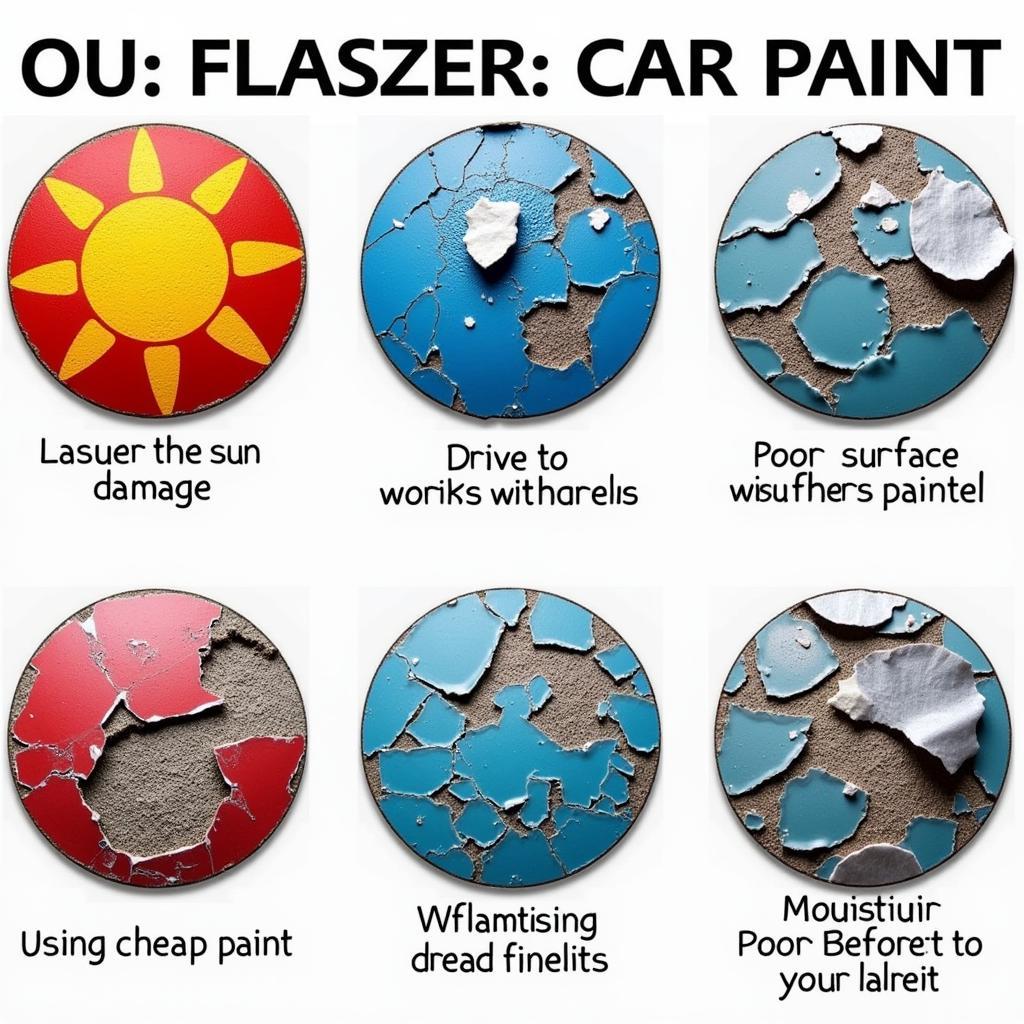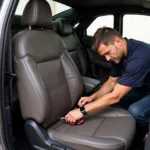Flaking car paint is a common problem that can make your vehicle look unsightly. It’s more than just an aesthetic issue, though, as it can also lead to rust and further damage. This comprehensive guide will show you how to repair flaking car paint yourself, saving you money and restoring your car’s finish. We’ll cover everything from identifying the cause to prepping the surface and applying the new paint. Let’s dive in.
Understanding why your car paint is flaking is the first step to a successful repair. Several factors contribute to flaking, including exposure to harsh weather conditions like UV rays and extreme temperatures, improper car washing techniques, or even poor quality paint jobs. Sometimes, it’s simply the age of the car catching up. Whatever the reason, addressing the flaking paint promptly is crucial to prevent further damage. You can learn more about spot repairs by visiting our guide on how to spot repair car paint.
Identifying the Cause of Flaking Paint
Before you start the repair process, it’s essential to determine what caused the paint to flake in the first place. Is it sun damage, improper washing, or perhaps a previous repair done poorly? Knowing the root cause will help you address the underlying problem and prevent the flaking from recurring. For instance, if it’s sun damage, you might consider using a car cover in the future.
Common Causes of Flaking
- Sun Damage: Prolonged exposure to UV rays can weaken the paint’s bond, leading to flaking and fading.
- Moisture: Trapped moisture under the paint can cause it to lift and peel away from the metal. This often happens around areas prone to rust, like wheel wells.
- Poor Surface Preparation: If the surface wasn’t properly cleaned and primed before the initial paint job, the paint may not adhere correctly, leading to flaking later on.
- Cheap Paint: Low-quality paint is more susceptible to flaking and fading than higher-grade paints.
 Flaking Car Paint Common Causes
Flaking Car Paint Common Causes
Gathering Your Supplies
Once you’ve identified the cause, it’s time to gather your supplies. You’ll need sandpaper (various grits), primer, car paint (matched to your car’s color), clear coat, masking tape, plastic sheeting, a sanding block, and safety equipment like gloves and a respirator. Having the right tools and materials on hand will make the repair process much smoother. You can also find information about professional car paint repairs near you by searching for “car repair and painting near me”.
Essential Tools and Materials
- Sandpaper (180, 320, and 400 grit)
- Primer
- Car paint (matched to your vehicle)
- Clear coat
- Masking tape
- Plastic sheeting
- Sanding block
- Gloves and respirator
- Tack cloth
- Rubbing compound (optional)
Preparing the Surface
The key to a professional-looking repair is proper surface preparation. Start by washing the affected area thoroughly and allowing it to dry completely. Then, use sandpaper to remove the loose and flaking paint. Start with a coarser grit (180) and gradually move to finer grits (320, then 400) to smooth the surface. This creates a good base for the primer and paint to adhere to. For specific advice on sanding and repairing car paint, refer to our guide on how to sand and repair car paint.
Sanding Techniques
- Feathering: Sand the edges of the flaking paint to create a smooth transition between the bare metal and the existing paint.
- Avoid Gouging: Apply even pressure while sanding to prevent gouging the metal surface.
- Cleanliness: Regularly wipe away the sanding dust with a tack cloth to ensure a clean surface.
Applying Primer and Paint
After sanding, apply a thin, even coat of primer to the bare metal. Allow the primer to dry completely before applying the car paint. Apply several thin coats of paint, allowing each coat to dry before applying the next. This builds up the color and provides better coverage. Finally, apply a clear coat to protect the paint and give it a glossy finish. You might find helpful information regarding specific car paint repairs by searching for “car paint repair luton” or “car paint repair tunbridge wells”.
Tips for Applying Primer and Paint
- Thin Coats: Applying several thin coats is better than one thick coat, which can lead to runs and drips.
- Even Strokes: Use smooth, even strokes to ensure an even application of paint.
- Proper Ventilation: Work in a well-ventilated area to avoid inhaling paint fumes.
Conclusion
Repairing flaking car paint can seem daunting, but with the right tools, materials, and techniques, it’s a manageable DIY project. By following these steps, you can restore your car’s appearance and prevent further damage. Addressing the issue promptly not only improves your car’s aesthetics but also protects its value. Remember to always prioritize safety by wearing appropriate protective gear.
FAQ
- How long does it take for car paint to dry? Drying time varies depending on the type of paint and environmental conditions, but it typically takes 24-48 hours for complete drying.
- Can I use any type of primer? It’s best to use an automotive primer specifically designed for car paint.
- What should I do if the flaking is extensive? For extensive damage, it’s best to consult a professional auto body shop.
- How can I prevent my car paint from flaking in the future? Regular washing, waxing, and using a car cover can help protect your paint from the elements.
- What type of sandpaper should I use for wet sanding? Wet sanding typically uses finer grits (1500-2000) and requires special waterproof sandpaper.
- How do I match my car’s paint color? Your car’s paint code can usually be found on a sticker inside the driver’s side doorjamb or in the owner’s manual.
- Can I repair flaking clear coat without repainting the entire car? Yes, it’s possible to repair flaking clear coat with spot repairs, but it requires careful preparation and blending.
For other car repair questions and solutions, browse our website for articles like “How to spot repair car paint” and “How to sand and repair car paint”. If you need personalized assistance, don’t hesitate to reach out. Contact us via WhatsApp: +1(641)206-8880 or Email: [email protected]. Our 24/7 customer support team is ready to assist you.


